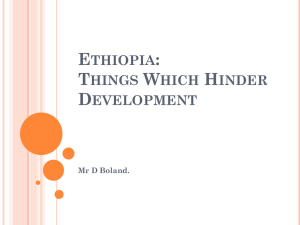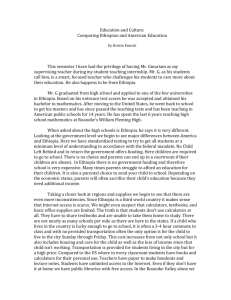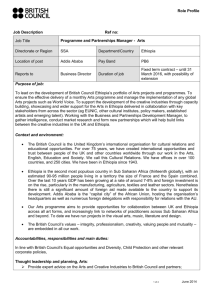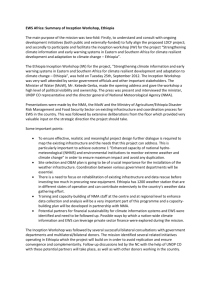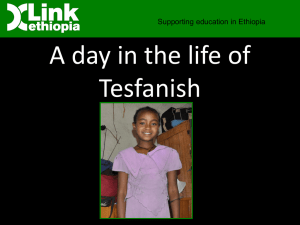CLIC–SR field study in Ethiopia: a reflection on methods, challenges
advertisement
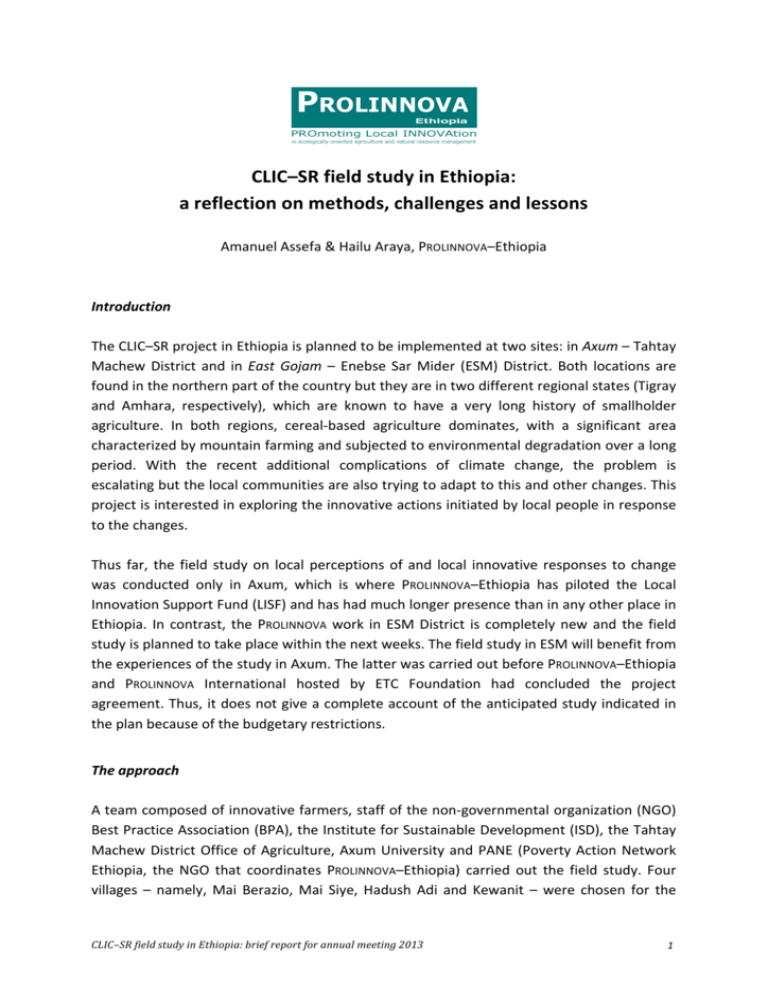
CLIC–SR field study in Ethiopia: a reflection on methods, challenges and lessons Amanuel Assefa & Hailu Araya, PROLINNOVA–Ethiopia Introduction The CLIC–SR project in Ethiopia is planned to be implemented at two sites: in Axum – Tahtay Machew District and in East Gojam – Enebse Sar Mider (ESM) District. Both locations are found in the northern part of the country but they are in two different regional states (Tigray and Amhara, respectively), which are known to have a very long history of smallholder agriculture. In both regions, cereal-­‐based agriculture dominates, with a significant area characterized by mountain farming and subjected to environmental degradation over a long period. With the recent additional complications of climate change, the problem is escalating but the local communities are also trying to adapt to this and other changes. This project is interested in exploring the innovative actions initiated by local people in response to the changes. Thus far, the field study on local perceptions of and local innovative responses to change was conducted only in Axum, which is where PROLINNOVA–Ethiopia has piloted the Local Innovation Support Fund (LISF) and has had much longer presence than in any other place in Ethiopia. In contrast, the PROLINNOVA work in ESM District is completely new and the field study is planned to take place within the next weeks. The field study in ESM will benefit from the experiences of the study in Axum. The latter was carried out before PROLINNOVA–Ethiopia and PROLINNOVA International hosted by ETC Foundation had concluded the project agreement. Thus, it does not give a complete account of the anticipated study indicated in the plan because of the budgetary restrictions. The approach A team composed of innovative farmers, staff of the non-­‐governmental organization (NGO) Best Practice Association (BPA), the Institute for Sustainable Development (ISD), the Tahtay Machew District Office of Agriculture, Axum University and PANE (Poverty Action Network Ethiopia, the NGO that coordinates PROLINNOVA–Ethiopia) carried out the field study. Four villages – namely, Mai Berazio, Mai Siye, Hadush Adi and Kewanit – were chosen for the CLIC–SR field study in Ethiopia: brief report for annual meeting 2013 1 study. The criteria used to select the villages include: population density, farm diversity, vulnerability to change, livelihood activities and distance from the main road. The study used questionnaires and focus group discussions (FGDs) as principal investigation tools but secondary data was also extensively used to understand trends and to speculate about the future. In this study, 40 questionnaires were completed and eight focus group discussions were held (two per village). The focus groups were selected purposely – based on the above stated site selection criteria, particularly farming diversity, vulnerability to change and engagements in more livelihood sources than farming. The key issues discussed in the FDGs and included in the survey instrument were: general information on households, major changes that took place over time, coping mechanisms / local innovation, and farmers’ sources of information/knowledge. Challenges and opportunities • The study team could not spend enough time in the field because the budget was not released and funds had to be drawn in the meantime from other sources • The study team and the farmers interviewed were attracted more to climate change issues, basically because it is a serious challenge but also because of the influence of the new Climate Resilience Economic Plan of the Government of Ethiopia on the people and the researchers. Other types of change that could have affected the lives of farmers were not covered adequately. • The fact that researchers from Axum University were present created an opportunity to inspire them for further engagement in participatory innovation development (PID). • Six innovations involving local adaptation to climate change were documented1 and most of them will be subjected to further development through PID together with researchers and other actors. Lessons learned Attitudinal changes Many people from public institutions and some NGOs put farmers on the demand side for knowledge, information and development initiatives. In other words, extension agents, researchers, and university professors assume that they are sitting on the supply side for knowledge and innovation. They assume that the lives of farmers could be improved only if the supply-­‐side knowledge system is strengthened. This attitude governs a wide range of 1 The six innovations identified were: Overcoming the challenge of Orobanche in vegetable production; Adapting to climate change through waterharvesting with microbasins; Improving survival strategy through beekeeping; Overcoming the tomato marketing challenge through better post-­‐harvest technology; Using Desmodium to control ant infestation of fruit trees; Overcoming the impact of pesticides on beekeeping. The results of the study (local perceptions and innovations) are reported separately. CLIC–SR field study in Ethiopia: brief report for annual meeting 2013 2 policymaking institutions in Ethiopia and, in turn, has significant effects on the national, regional and local development agendas and programmes. This field study, however, had an impact on the team members in terms of opening up new thoughts about farmers’ capacity to innovate, particularly in response to the changes they are facing at local level. The team members also agreed that innovative farmers did not receive enough recognition and support despite the great work they are doing in climate-­‐risk-­‐prone and limited-­‐resource situations. Diverse approaches for identification of innovation The team also learned that identifying local innovation through the questionnaire survey and FGDs in one go is a very good starting point, but the process needs to be continued. Identifying innovations is not at all a one-­‐time activity but the initial step is usually very helpful to trigger the work, which requires repeated attempts involving various methods. For example, the approach in LISF, which involves a call for self-­‐targeting of local innovators is incredibly important. The method of advertisement might not necessarily be via the modern media like radio, television or Internet, but through the existing (non-­‐digital) social networks. It is much easier and less expensive to use this approach to identify innovations than the conventional survey method. One can use the self-­‐targeting approach every year or periodically. This is only one example, but the project should be able to develop more innovative tools to make sure all existing innovations are adequately covered. Conceptual clarity The team members involved in the field study came from different schools of thought and institutions. It was very difficult to speak the same language about the concept of innovation throughout the process. It is therefore important to hold a conceptual discussion before starting the study and make sure that everybody is on the same page. It is perhaps important to organize a half-­‐day workshop on concepts and perspectives before entering into the collective work to identify innovation. Comprehensive methodology needed A well-­‐thought-­‐through methodology is still required to address the other types of changes at farmer/household level. Many people are pre-­‐occupied with the climate-­‐change issue, which has received extensive coverage in media, local politics, donors and academia. However, climate change is only one important change to be addressed in this project and there are several policy, legislative, institutional, market and political changes that are equally affecting the lives of the people. The outcome of this particular study showed that six local innovations with potential of further development could be identified, but all were concerned with issues of adaptation to climate change. It is therefore necessary to develop a methodology that will be able to accommodate all the other sources of change and the corresponding innovations. CLIC–SR field study in Ethiopia: brief report for annual meeting 2013 3



